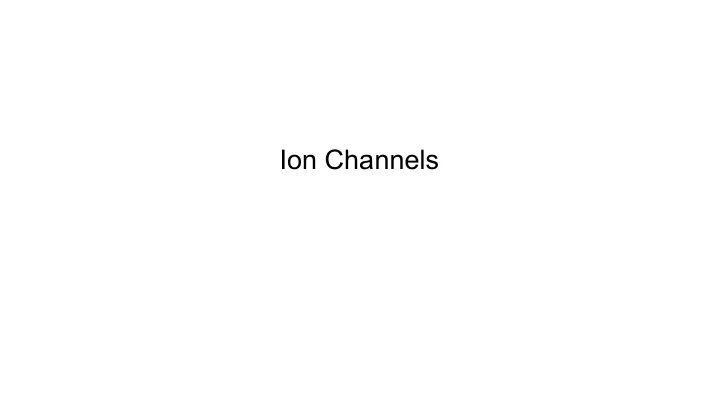

Ion Channels
Question: what is the nature of ‘animal spirits’ ? Luigi Galvani
Conclusion: there is bio-electricity, electrical forces that are intrinsic to the animal (animal electricity)
Question: what is the electrical potential signal of the “excitatory process” in muscle and nerves? Julius Bernstein Injury current (Carlo Matteucci)
Conclusion : a fast voltage change that is larger then a “resting” potential
Question: what is the physico-chemical nature of bioelectric events?
“ Let us imagine that these electrolytes diffuse unhindered from the axial cross section of the fibrils into the surrounding fluid, while they are prevented from diffusing through the longitudinal section by an intact plasmalemma which is impermeable to one kind of ion such as the anion (PO − 4 etc.) to a greater or lesser degree. Then an electrical double layer would emerge at the surface of the fibril, with negative charges towards the inside and positive charges towards the outside. Indeed, this electrical double layer must also exist in the undamaged fiber, but would become apparent only in response to lesion or stimulation (negative variation). This assumption would imply a theory of pre-existence. As the semipermeable membrane plays an essential role in this theory, I will succinctly call it ‘ Membrane Theory ’ .” Conclusion : ions separated by a membrane with selective permeability, which breaks down during impulses
Question: is the membrane breakdown hypothesis correct?
Wheatstone bridge Kacy Cole and Howard Curtis, 1939
Conclusion : Membrane breakdown hypothesis holds
Question: is the membrane breakdown hypothesis correct? Alan Hodgkin and Andrew Huxley, 1939
Kacy Cole and Howard Curtis, 1939 Alan Hodgkin and Andrew Huxley, 1939
Conclusion : Membrane breakdown hypothesis needs revising
Question: is sodium responsible for the overshoot of the action potential? Conclusion : Yes
Question: what are the ionic currents that generate the action potential?
Conclusion : Fast activating/inactivating sodium current and slow activating/non-inactivating potassium current
Question: how do ions cross membranes? (Armstrong & Binstock 1965) (Narahashi 1964)
Conclusion : It is most likely a pore
Question: How can a pore be selective?
Kcsa channel
Conclusion : It’s a pore, and the energy landscape determines selectivity
Question: How is a channel gated by voltage? (Keynes & Riojas 1974) (Armstrong & Bezanilla 1973)
* Shaker Kv1.2 Kv2.1 Kv3.1 Kv4.1
Helical screw model of S4 movement (Catterall 1986, Guy 1986)
Conclusion : movement of charged residues lining the pore
A voltage-gated ion channel VSD Pore A B Selectivity filter S5 S6 S1 S2 S3 S4 1 2 4 + 3 + + + NH 2 COOH C Closed Open outside outside + + + + Δ V + + + + + + + + + + + + - - - - - inside inside + + + + +
Question: how is functional diversity generated? TRPA1
GluA2 CaV1.1 CNG EAG Slo2.2 HCN1 S l o 2 BK . 2 hERG KCNQ1
Recommend
More recommend